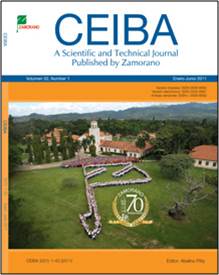Contribuciones de Zamorano a la Acuacultura Latinoamericana
DOI:
https://doi.org/10.5377/ceiba.v52i1.969Palabras clave:
Capacitaciones técnicas, piscicultura, reversión sexual, tilapiaResumen
Activities in aquaculture were begun in Zamorano in 1976 with the stocking of 400 fingerlings of the Java tilapia (Tilapia mossambica, now Oreochromis mossambicus) in a pond recently constructed for this purpose. Since then Zamorano has contributed to promoting aquaculture by training persons interested in farming fish and crustaceans, developing appropriate infrastructure and through varied and frequent research and extension activities. The most significant Zamorano accomplishments in aquaculture have been to train more than 7000 persons on the fundamentals of aquaculture and the distribution of more than 10,000 copies of several technical manuals on the topics of aquaculture and culture of tilapia. Technicians from Zamorano have offered short courses on these topics in ten different countries since 1990. Research efforts in aquaculture have focused on the utilization of the hormone 17-Alpha-Methyl-Testosterone in controlling the sex of tilapia fry, developing the infrastructure and management protocols for tilapia broodstock, efficient use of feeds and feeding fish and shrimp, the adaptability of tilapia to saline and brackish water, and environmental studies.
Descargas
1156




